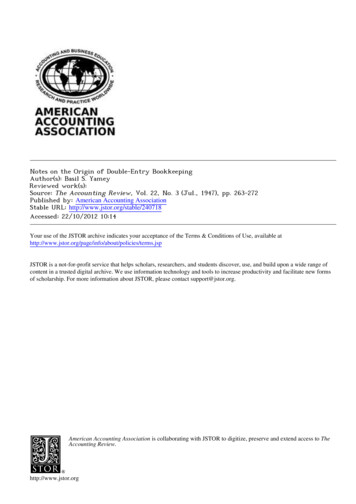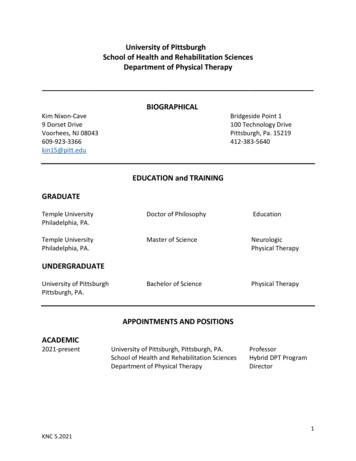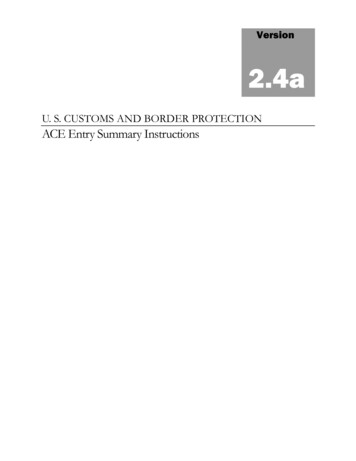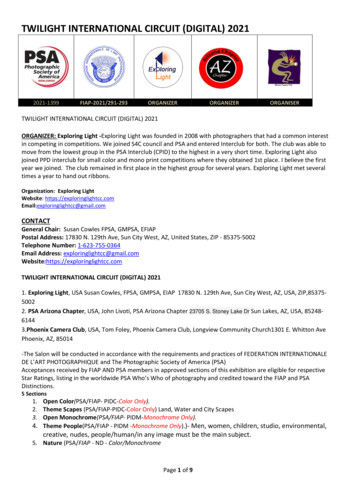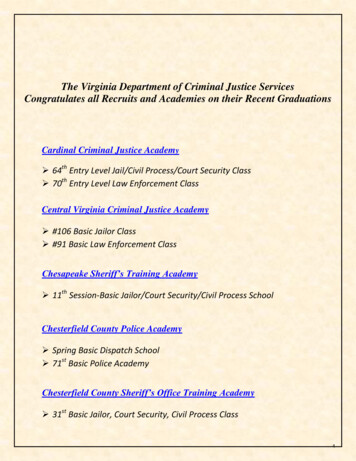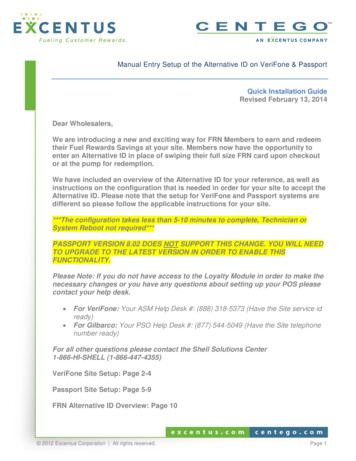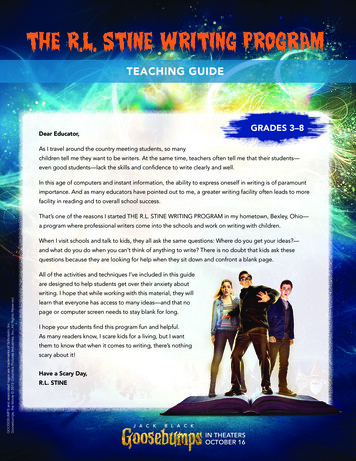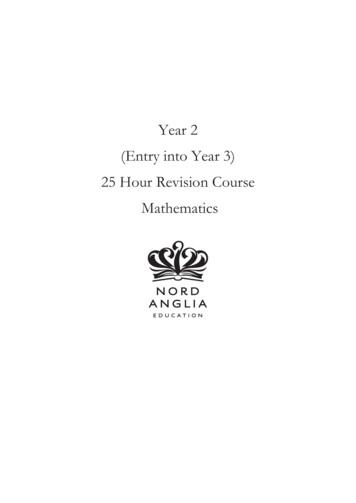
Transcription
Year 2(Entry into Year 3)25 Hour Revision CourseMathematics
Section 1 – Column Sums2 hours 1
Place Value: Using Columns for NumbersPutting numbers in columns makes it easy for us to make lots of different numbers using thesame digits. The position or place of each digit – which column it is in – tells us its value.In the examplebelow, you can see that above the numbers, we have written Th, H, T, and U. These stand forThousands, Hundreds, Tens, and Units.From this, you can see that we have 1 Ten and 4 Units. This is read as 14 (Fourteen).In this example, we have 3 Hundreds, 7 Tens, and 8 Units. This is read as 378 (Three Hundred andSeventy Eight)In this example, we have 4 Thousands, 2 Hundreds, 5 Tens, and 6 Units. This is read as 4256 (FourThousand, Two Hundred and Fifty Six) 2
AdditionWhenever possible, you should try to add numbers in your head. To do this, you usually need to breakup, or partition, a number into its different parts (into tens and units, for example) before adding oneach part separately.For example, when adding 28 to 46, it is simpler to break up 28 into 20 and 8 before doing any adding.A number line can be used to help you. 20 8466674To begin with, you might find drawing a number line helpful, but as you grow in confidence you shouldbe able to add two numbers that are both less than 100 in your head.Have a go at answering the questions below in your head (you can draw a number line if it helps). 3
Addition using the Column MethodAs well as adding up in our heads, we can also use the Column Method. This is particularly useful ifthe numbers are too big to add in your head. The Column Method involves lining both sums aboveeach other with the Tens and Units in the right place. An addition sum using the Column Methodlooks like this:(H stands for Hundreds, T stands for Tens, and U stands for Units)In this sum we have 314 (3 Hundreds, 1 Ten and 4 Units) plus 452 (4 Hundred, 5 Tens and 2 Units).With Column sums, we always start on the right-hand side.4 plus 2 is 6. This is put underneath, between the answer lines.Next we look at the Tens Column, adding 10 and 50 together to make 60. The zero is dropped, andthe 6 is placed in the Tens Column. 4
Finally, we look at the Hundreds Column, adding 300 and 400 to get 700. 5
Often we have to carry from one Column to the next. When this happens, we need to leave a mark toremember to add it later.For example,Here, 7 add 5 is 12. We fill in the numbers like this:For the next Column, we add the two numbers at the top (3 and 8) and then add the new numberbelow the answer box. 6
Finally, add the numbers in the Hundreds Column. 7
Using the information shown above, work out the following: 8
9
10
11
SubtractionThere are two ways of thinking about subtraction: counting back or counting on. Counting back is justanother way of saying ‘take away’.For example,-6891011121314Counting on involves finding the difference between the two numbers by counting on from thesmallest to the largest.Using the same example,867891011121314The result of each of these approaches is obviously the same. Which method you use will often dependon the numbers you are working with. When the number you are subtracting is small (65 – 3), it usuallymakes more sense to count back. When the number you are subtracting is large (65 – 62), it usuallymakes more sense to count on. 12
Work out the answers to the following questions in your head. You will first need to decide whether itmakes more sense to count back or count on. 13
Column SubtractionColumn Subtraction is very similar to Column Addition, although here we introduce a new trick –taking from another Column. This is necessary when the top number in the Column is smaller thanthe bottom number, like this;As 2 is less than 7, we have to take from 1 from the 4 in the Tens Column. To do this, we cross outthe number in the next column along on the left, and write the number one less than it above it. Wethen take the one and put it next to the top unit that was too small originally. It should look somethinglike this:We then subtract as normal. 14
Now try some subtractions of your own. 15
16
17
Section 2 – Number Bonds2 hours 18
Number BondsNumber Bonds are simple sums that need to be learnt by heart.For each of the sums below, please try to work out what the value of the missing number.The first question has been done for you.Addition To Ten 19
20
Addition To Twenty 21
22
23
Subtraction from Ten 24
25
Subtraction from Twenty 26
27
28
Simple Number Bonds to One Hundred 29
30
Section 3 – Deductive Maths1.5 hours 31
Deductive MathsSometimes in Maths, when we are given the answer to one sum, we can use the answer towork out the answer to other questions.For exampleUse this logic to work out the answers to the following questions; 32
33
Number SequencesLook at the following sequences of numbers and try to work out the next 3 numbers in thesequences. For each line, please explain why you have given the answers you have. 34
35
Working out Original NumbersRead the questions below, and try to work out the original numbers 36
37
38
Section 4 – Vocabulary of Maths0.5 hours 39
Vocabulary of NumbersCardinal Numbers 40
41
Using the vocabulary above, please write out the following figures in words: 42
Ordinal NumbersOrdinal numbers refer to the position of a number in a list. Below is a list of ordinal numbers. 43
44
Section 5 – Rounding1 hours 45
RoundingSometimes it is not necessary to give an exact answer. If asked how many children there are ina school, for example, we would probably say ‘about 400’ rather than ‘387’. Here, we have rounded thenumber to the nearest Hundred.When rounding to the nearest Ten or nearest Hundred, you must first work out which two Tens orwhich two Hundreds the number is between before then deciding which it is closest to.For example, 84 is between 80 and 90, but it is closest to 80 (it is four away from 80 and six away from90) and so if we had to round it to the nearest Ten we would round it to 80.If a number is exactly half-way between two Tens or Two Hundreds, then we always round up. Forexample, 250 is fifty away from 200 and fifty away from 300, but it is rounded up to 300.For the numbers below, work out what two Tens the number is between and then say which it isrounded to.For example; 46
47
For the numbers below, work out what two Hundreds the number is between and then say which it isrounded to.For example 48
49
Round the following numbers to the nearest 10 50
Section 6 – Multiplication4.5 hours 51
MultiplicationMultiplication can be thought of as repeated addition.For example, 3 x 4 can be thought of as ‘3 lots of 4:For each of the sums below, show the repeated addition required and find the answer. 52
53
54
Below is a list of Times Tables. These need to be learnt off by heart. Take time to learn each one. Tryrepeating them out loud, or get a friend or member of your family to sit with you and go through them.It takes time, but this will be very important soon, and you will need to know everything here.Next to the tables below, copy each sum out twice more for practice.Two-times Table (2x) 55
Three-times Table (3x) 56
Four-times Table (4x) 57
Five-times Table (5x) 58
Six-times Table (6x) 59
Seven-times Table (7x) 60
Eight-times Table (8x) 61
Nine-times Table (9x) 62
Ten-times Table (10x) 63
Eleven-times Table (11x) 64
Twelve-times Table (12x) 65
In the multiplication grid below, please fill in all of the sums as best as you can. Someanswers have been filled in for you.(A Tip: Start with the times tables you already know – by filling in 1x, 2x, 5x, and 10x, you will see thata large amount of the grid is quickly filled) 66
Fill in the following multiplication grids in the same way. You will notice that it is not quiteas easy with these! 67
68
69
In the multiplication grid below, please circle all numbers that are a multiple of 4. 70
In the multiplication grid below, please circle all numbers that are a multiple of 5. 71
Mental Maths QuizWork out the following multiplication sums as quickly as you can. Try to do them in yourhead, but if you must write something, find the answer however you wish. 72
Section 7 – Division2 hours 73
DivisionJust as Multiplication can be explained as repeated addition, Division can be explained asrepeated subtraction. One method of dividing is by subtracting the second number as many times asnecessary until we reach zero.For example; For each of the sums below, show the repeated addition required and find the answer. 74
4 75
Bus Stop DivisionAnother method that we can use to divide is the Bus Stop method. It is called this because the numberthat we’re looking to divide hides under a roof where the answer sits.For the sum above, start by working out how many times two goes into 1. It doesn’t, so we then askhow many times 2 goes into 16. It goes into 16, 8 times, and we write the answer like this;Some division will not give a nice, easy answer. Sometimes we are left with remainders. We work thisout like this;Start by working out how many times two goes into two. It goes once, so we write 1 above the two.Next we work out how many twos there are in five. There are 2 twos in 5, so we write a 2 above thefive. However, we are left with one left over. This is written on the side like this; 76
The answer is 12, remainder 1.Sometimes, we will be left with a remainder in the middle of the sum – If this is the case, we move itinto the next column.Here we begin by working out how many twos there are in five. There are 2, with 1 remainder. The 2is placed above the 5, while the one goes next to the 4. We then work out how many twos there are infourteen. There are 7, with no remainder, making the answer 27.(As you can see, it is very important to know your Times Tables – if you are struggling to rememberhow many times a number goes into another number, please revise the tables in the Multiplicationsection) 77
Solve the divisions below using the Bus Stop Method 78
79
80
81
Section 8 – Factors1 hours 82
FactorsFactors are numbers that can be multiplied exactly with another whole number to produce athird number, n. We can work out which numbers are factors of another by dividing n with potentialfactors. The factors are the numbers that, when divided, give a whole number (integer).For example:Find all of the Factors of 6From this, we can see that the factors of 6 are 1, 2, 3, and 6 83
Hence, or otherwise, please find all of the factors of the following numbers; 84
NB.It may help you to think of Times Tables when trying to work out factors. Whichmultiples go into each of the numbers above? 85
Section 9 – Fractions2 hours 86
FractionsA Fraction is a numerical value that is not a whole number. In practice, this means part orpiece of a whole number. Well known fractions include a half, (1/2), or a quarter (1/4).Fractions are made up of two 𝑛𝑜𝑚𝑖𝑛𝑎𝑡𝑜𝑟The Denominator is the total number of parts that a whole number has been split into. The Numeratoris the number of smaller parts that have been kept.In the example below, we have divided a circle into six sections, 87
This means that the denominator for this shape will be 6. We then colour a number of the sections in.In this shape, 4 of the 6 sections are coloured in. This means that for this shape, the fraction will be46For each of the shapes shown below, please write the fraction beside it; 88
For each of the shapes shown below, please colour in the required fraction;𝟒𝟖𝟑𝟓𝟐𝟔𝟒𝟓𝟏𝟔 89
Adding Simple Fractions (8 )Simple fractions are fractions where the denominator is the same for both parts of the sum. If thedenominator is the same, we simply add the numerators together.For example;1 12 3 33 Now work through the following questions below;1 1 4 42 1 5 5 90
3 2 7 74 2 6 653 10 1046 17 1795 18 1820 15 50 50 91
13 12 65 6554 192 192 92
Subtracting Simple FractionsAs with for adding Simple fractions, if the denominator is the same, we simply subtract the numerators.For example;2 11 3 33Now work through the following questions below;31 444 1 5 56 2 7 7 93
22 6653 10 10138 171795 18 182015 505032 12 65 65 94
6017 192 192 95
Section 10 – Doubling and Halving1.5 hours 96
Doubling and HalvingDoubling a number means to multiply it by 2.e.g.What is double 4?Double 4 is 8Halving is the opposite to Doubling, as it involves dividing a number by 2.e.g.What is half of 12? Half of 12 is 6Using the information above, please work out what DOUBLE of the following numbersis. 97
98
99
100
Now we will look at halving numbers – try to work out the answers to the questions below; 101
102
103
104
Section 11 – Time3.5 hours 105
Important Facts about Time and Date 106
Telling the Time using an Analogue ClockAnalogue clocks look like this. They are circles, often divided into 12 sections with a number on each.This is very helpful for us. As you may already know, an hour is made up of 60 minutes, and 60 dividedby 12 is 5. This means that each number on the clock means that 5 minutes has passed. However, the12 numbers also refer to 12 hours.We tell them apart by using two different hands on the clock – one long and one short. The long handhelps us to tell the minutes in the hour, while the short hand refers to the hours. 107
The big hand (red) is pointing to 12, which means zero minutes, and the short hand is pointing to 2.We say that this is 2 o’clock.What time is it in the following clocks? 108
109
Half-PastWhen the long, red, minute hand is at the bottom of the clock, pointing at the number 6, thatmeans that 30 minutes have passed in the hour. At this point, 30 of the 60 minutes have passed, so wesay that it is ‘Half Past’.At this point, we then have to work out which hour we are ‘Half Past’. To do this, look at the clockagain, and see where the short hour hand is. It has gone past one hour, but has not reached the nexthour.For example;In this example, the short, green, hour hand is between 6 and 7. This means that the time is 6.30.Please work out the time for each of the clocks below; 110
111
112
Quarter past, and Quarter toWhen the minute hand (long hand) rests on 3, 15 minutes have passed in the hour. We callthis ‘Quarter past ( an hour)’.To find out which hour it is ‘Quarter past’, we need to look at the shorter hand.In this example, the short, green, hour hand has moved just past 6. This means that the time here is‘Quarter past Six’.Now work out the time for each of the following clocks; 113
114
When the minute hand (long hand) rests on 9, 45 minutes have passed in the hour. We call this ‘Quarterto ( an hour)’.To find out which hour it is ‘Quarter to’, we need to look at the shorter hand again. Instead of lookingat which hour we have just passed, we look at which hour is to come.In this example, the short, green, hour hand is about to reach 3. This means that the time here is‘Quarter to Three’.Now work out the time for each of the following clocks; 115
116
117
For times which are not ‘Half Past’, ‘Quarter Past’, or ‘Quarter To’, we need to take a little extra carewhen trying to tell the time.On the clock above, you will notice that there are sixty little notches, each of which signifies oneminute. If the minute hand is in the right half of the clock, we use ‘Past’ and count the number ofminutes that have elapsed. For times that use past, we need to look at the previous hour to completethe time.For example; 118
On this clock, 22 minutes have past since 11, so the time is ’22 past 11’ or ’11.22’. 119
If the minute hand is on the left side on the clock face, we have to use ‘To’. As with ‘Quarter to’, weneed to look at the next hour so, for example,From the top of the clock, count left. There are 8 minutes until we reach the red minute hand, and thenext hour is 10, so the time is ‘Eight Minutes to 10’.Please work out the time for the clocks below; 120
121
122
Section 12 – Money1 hour 123
MoneyThere are currently 8 coins in circulation in Great Britain – these are shown below. They are1p, 2p, 5p, 10p, 20p, 50p, 1, and 2.For each of the groups below, work out how much money is in each group.1)2)3) 124
4)5) 125
Section 13 – General Test1.5 hours 126
General Revision Test 127
128
129
130
131
132
133
134
135
136
25 Hour Revision Course Mathematics 1 Section 1 – Column Sums 2 hours 2 Place Value: Using Columns for Numbers Putting numbers in columns makes it easy for us to make lots of different numbers using the same digits. The position or place of each digit –

